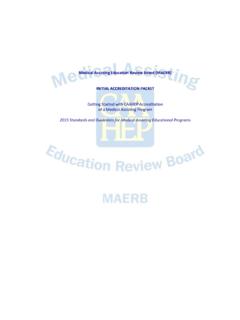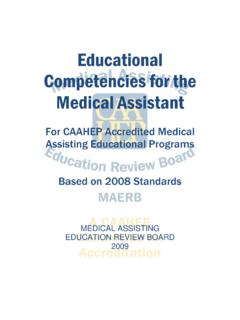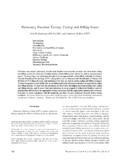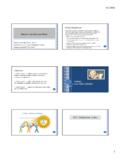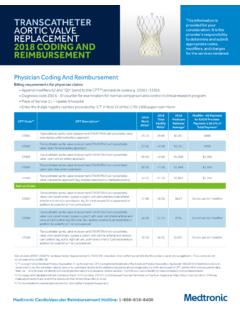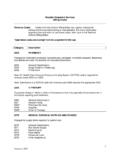Transcription of Educational Competencies for the Medical Assistant
1 Educational Competencies for the Medical Assistant For CAAHEP Accredited Medical Assisting Educational Programs Based on 2008 Standards Medical ASSISTING EDUCATION REVIEW BOARD 2009 Educational Competencies for the Medical Assistant 2008 Standards 2 Introduction Development of the Educational Competencies for the Medical Assistant The Medical Assisting Education Review Board (MAERB) assumed responsibility for drafting revisions to the Educational Competencies for a Medical Assistant (ECMA), bringing the document into agreement with the entry-level Competencies found in the psychomotor and affective domains as identified in the Commission of Accreditation of Allied Health Education Programs (CAAHEP) 2008 Standards and Guidelines for Medical Assisting Educational Programs (2008 Standards) in Appendix B. The original document was developed by educators from across the country. The final review and editing of this revision of the ECMA was conducted by the MAERB.
2 Use of the MAERB Educational Competencies for the Medical Assistant The Educational Competencies for the Medical Assistant can be used in a variety of ways by educators, practitioners, physicians and AAMA members. The intended purpose of this document is to provide Suggested Evaluation Methods for meeting each of the entry-level Competencies as found in the 2008 Standards. It is not intended that all of the suggested methods of evaluation for each competency included in a curriculum for purposes of accreditation, but this document provides ideas and evaluation methods that can be used to meet the Competencies . Documentation of achievement of all Competencies found in the psychomotor and affective domains must be evaluated in a manner consistent with the action verb. The 2008 Standards (Appendix B) identifies 128 tasks as determined to be entry-level Competencies , through an occupational analysis. The entry-level Competencies are clearly identified in the heading of each page of this document.
3 Listed under each Entry-Level Competency are outlines of related theory and suggested methods of evaluation. The theory and suggested methods of evaluation are provided as a curricular guide for educators in developing cognitive objectives, performance objectives, evaluation instruments and teaching materials and methods. The scope and depth to which they are included in a Medical assisting program is an individual program decision. This decision should be based on outcome assessment criteria by the communities of interest such as employer requirements of the local area, graduate recommendations, and advisory committee suggestions. In summary, there are 128 entry-level Competencies required by the 2008 CAAHEP Standards. The suggested theory and evaluation methods in the ECMA serve as a guide for Medical assisting educators in developing these Competencies as dictated by the local community of interest, the Educational facility and the needs of students in acquiring entry-level employment.
4 Also identified are those Competencies that require a work product. (See Table of Contents) Educational Competencies for the Medical Assistant 2008 Standards 3 TABLE OF CONTENTS * Competencies which require work products. Competencies in Psychomotor & Affective Domains as found in 2008 Standards I. Anatomy & Physiology Psychomotor Domain 1. Obtain vital signs .. 7 2. Perform venipuncture .. 7 3. Perform capillary puncture .. 8 4. Perform pulmonary function testing * .. 8 5. Perform electrocardiography * .. 9 6. Perform patient screening using established protocols * .. 9 7. Select proper sites for administering parenteral medication .. 9 8. Administer oral medications * .. 10 9. Administer parenteral (excluding IV) medications* .. 11 10. Assist physician with patient care .. 13 11. Perform quality control measures * .. 14 12. Perform CLIA-Waived hematology testing * .. 15 13. Perform CLIA-Waived chemistry testing *.
5 15 14. Perform CLIA-Waived urinalysis * .. 15 15. Perform CLIA-Waived immunology testing * .. 16 16. Screen test results * .. 16 Affective Domain 1. Apply critical thinking skills in performing patient assessment and care .. 16 2. Use language/verbal skills that enable patients understanding .. 17 3. Demonstrate respect for diversity in approaching patients and families .. 17 II. Applied Mathematics Psychomotor Domain 1. Prepare proper dosages of medication for administration * .. 18 2. Maintain laboratory test results using flow sheets * .. 18 3. Maintain growth charts * .. 18 Affective Domain 1. Verify ordered doses/dosages prior to administration .. 19 2. Distinguish between normal and abnormal test results * .. 19 III. Applied Microbiology/Infection Control Psychomotor Domain 1. Participate in training on Standard Precautions .. 20 2. Practice Standard Precautions .. 20 3. Select appropriate barrier/personal protective equipment (PPE) for potentially infectious situations.
6 20 4. Perform handwashing .. 21 5. Prepare items for autoclaving .. 21 6. Perform sterilization procedures .. 21 7. Obtain specimens for microbiological testing .. 22 8. Perform CLIA-waived microbiology testing * .. 22 Affective Domain 1. Display sensitivity to patient rights and feelings in collecting specimens .. 23 2. Explain the rationale for performance of a procedure to the patient .. 23 3. Show awareness of patients concerns regarding their perceptions related to the procedure being performed .. 24 Educational Competencies for the Medical Assistant 2008 Standards 4 IV. Concepts of Effective Communication Psychomotor Domain 1. Use reflection, restatement and clarification techniques to obtain a patient history .. 25 2. Report relevant information to others succinctly and accurately * .. 25 3. Use Medical terminology, pronouncing Medical terms correctly, to communicate information, patient history, data and observations.
7 25 4. Explain general office policies .. 26 5. Instruct patients according to their needs to promote health maintenance and disease prevention .. 26 6. Prepare a patient for procedures and/or treatments .. 27 7. Demonstrate telephone techniques .. 27 8. Document patient care * .. 28 9. Document patient education * .. 29 10. Compose professional/business letters * .. 29 11. Respond to nonverbal communication .. 30 12. Develop and maintain a current list of community resources related to patients healthcare needs * .. 30 13. Advocate on behalf of patients .. 30 Affective Domain 1. Demonstrate empathy in communicating with patients, family and staff .. 31 2. Apply active listening skills .. 31 3. Use appropriate body language and other nonverbal skills in communicating with patients, family and staff .. 31 4. Demonstrate awareness of the territorial boundaries of the person with whom communicating.
8 32 5. Demonstrate sensitivity appropriate to the message being delivered .. 32 6. Demonstrate awareness of how an individual s personal appearance affects anticipated responses .. 32 7. Demonstrate recognition of the patient s level of understanding in communication .. 32 8. Analyze communications in providing appropriate responses/feedback .. 33 9. Recognize and protect personal boundaries in communicating with others .. 33 10. Demonstrate respect for individual diversity, incorporating awareness of one s own biases in areas including gender, race, religion, age and economic status .. 33 V. Administrative Functions Psychomotor Domain 1. Manage appointment schedule, using established priorities * .. 34 2. Schedule patient admissions and/or procedures * .. 34 3. Organize a patient s Medical record * .. 34 4. File Medical records .. 34 5. Execute data management using electronic healthcare records such as the EMR *.
9 34 6. Use office hardware and software to maintain office systems * .. 35 7. Use internet to access information related to the Medical office * .. 35 8. Maintain organization by filing .. 35 9. Perform routine maintenance of office equipment with documentation * .. 35 10. Perform an office inventory * .. 35 Educational Competencies for the Medical Assistant 2008 Standards 5 Affective Domain 11. Consider staff needs and limitations in establishment of a filing system .. 36 12. Implement time management principles to maintain effective office function .. 36 VI. Basic Practice Finances Psychomotor Domain 1. Prepare a bank deposit * .. 37 2. Perform accounts receivable procedures, including: a. Post entries on a daysheet * .. 37 b. Perform billing procedures * .. 37 c. Perform collection procedures * .. 37 d. Post adjustments * .. 37 e. Process a credit balance * .. 37 f. Process refunds * .. 37 g. Post non-sufficient fund (NSF) checks *.
10 37 h. Post collection agency payments * .. 37 3. Utilize computerized office billing systems * .. 37 Affective Domain 1. Demonstrate sensitivity and professionalism in handling accounts receivable activities with clients .. 38 VII. Managed Care/Insurance Psychomotor Domain 1. Apply both managed care policies and procedures * .. 39 2. Apply third party guidelines * .. 39 3. Complete insurance claim forms * .. 39 4. Obtain precertification, including documentation * .. 39 5. Obtain preauthorization, including documentation * .. 39 6. Verify eligibility for managed care services * .. 39 Affective Domain 1. Demonstrate assertive communication with managed care and/or insurance providers .. 39 2. Demonstrate sensitivity in communicating with both providers and patients .. 39 3. Communicate in language the patient can understand regarding managed care and insurance plans .. 40 VIII. Procedural and Diagnostic Coding Psychomotor Domain 1.
